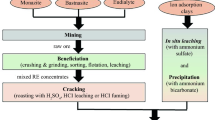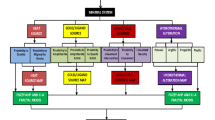Abstract
Microdiamonds offer several advantages as a resource estimation tool, such as access to deeper parts of a deposit which may be beyond the reach of large diameter drilling (LDD) techniques, the recovery of the total diamond content in the kimberlite, and a cost benefit due to the cheaper treatment cost compared to large diameter samples. In this paper we take the first step towards local estimation by showing that micro-diamond samples can be treated as a regionalised variable suitable for use in geostatistical applications and we show examples of such output. Examples of microdiamond variograms are presented, the variance-support relationship for microdiamonds is demonstrated and consistency of the diamond size frequency distribution (SFD) is shown with the aid of real datasets. The focus therefore is on why local microdiamond estimation should be possible, not how to generate such estimates. Data from our case studies and examples demonstrate a positive correlation between micro- and macrodiamond sample grades as well as block estimates. This relationship can be demonstrated repeatedly across multiple mining operations. The smaller sample support size for microdiamond samples is a key difference between micro- and macrodiamond estimates and this aspect must be taken into account during the estimation process. We discuss three methods which can be used to validate or reconcile the estimates against macrodiamond data, either as estimates or in the form of production grades: (i) reconcilliation using production data, (ii) by comparing LDD-based grade estimates against microdiamond-based estimates and (iii) using simulation techniques.







Similar content being viewed by others
References
Bush DE (2010) An overview of the estimation of kimberlite diamond deposits. The Southern African Iinstitute of mining and metallurgy. Diamonds – source to use 2010. pp 73–84
Chapman JG, Boxer GL (2004) Size distribution analyses for estimating diamond grade and value. Lithos 76:369–375
Chiles J-P, Delfiner P (1999) Geostatistics – modeling spatial uncertainty. Wiley USA
David M (1977) Geostatistical ore reserve estimation. Elsevier Scientific, Amsterdam New York, 364 pp
Deakin AS, Boxer GL (1989) Argyle AK1 diamond size distribution: the use of fine diamonds to predict the occurrence of commercial sized diamonds. Proceedings of the 4th international kimberlite conference: kimberlites and related rocks, Vol 2, their mantle/crust setting, diamonds and diamond exploration. Special publication – Geological Society of Australia, 14, pp 1117–1122
Dohm CE (2004) Quantifiable mineral resource classification: A logical approach. Leuangthong O and Deutsch CV (eds) Geostatistics Banff 2004, pp 333–342
Fulop A, Kopylova M, Ellemers P, Squibb C (2017) Geology of the snap Lake kimberlite dyke, northwest territories, Canada, and its metasomatic interaction with granite. 11th international kimberlite conference extended abstract no. In: 11IKC-4528
Hammer PTC, Clowes RM, Ramachandran K. (2004) Seismic reflection imaging of thin, kimberlite dykes and sills:exploration and deposit characterization of the Snap Lake dyke, Canada. Proc. 8th international kimberlite conference: The C. Roger Clement volume (1). Lithos special publication, 76/1–4, pp 359–367
Isaaks EH, Srivastava RM (1989) An introduction to applied geostatistics. Oxford University Press, New York, 561 pp
Journel AG, Huijbregts CJ (1978) Mining geostatistics. Blackburn press, USA
Kirkley MB, Mogg T, McBean D (2003) Snap Lake field trip guide. In: Kjarsgaard BA (ed) 8th international kimberlite conference, slave province and northern Alberta field trip guidebook, pp 1–12
Matheron G (1971) The theory of regionalized variables and its applications. Center for geostatistics, Fontainebleau
Matheron G (1973) The intrinsic random functions and its applications. Center for geostatistics, Fontainebleau
McBean D, Kirkley M, Revering C (2003) Structural controls on the morphology of the Snap Lake kimberlite dyke. Extended abstracts of the 8th international kimberlite conference, Victoria, Canada, pp 69–74
Myers DE (1989) To be or not to be……stationary? That is the question. Math Geol 21(3):347–362
Parker HM, Dohm CE (2014) Evolution of mineral resource classification from 1980 to 2014 and current best practice. Finex ‘14 Julius Wernher memorial lecture. Minsouth, a society of the IOM3. London. www.crirsco.com/docs/H_Parker_Finex.pdf. Accessed 23 October 2015
Rombouts L (1995) Sampling and statistical evaluation of diamond deposits. J Geochem Explor 53:351–367
Sinclair AJ, Blackwell GH (2002) Applied mineral inventory estimation. Cambridge University Press
Stiefenhofer, J. (2013). The use of chemical and metallurgical parameters to enhance the economic value of kimberlite resource models. The Southern African Institute of Mining and Metallurgy. Diamonds – Source to use 2013. Proceedings vol, pp 1–18
Stiefenhofer J, Thurston ML, Rose DM, Chinn IL, Ferreira JJ (2016) Principles relating to the use of micro-diamonds for resource estimation: 1 – the impact of mantle and kimberlite processes. Can Inst Min J 7(4)
Van Straaten B, Kopylova M, Russell K, Webb K, Scott Smith B (2008) Discrimination of diamond resource and non-resource domains in the victor north pyroclastic kimberlite, Canada. J Volcanol Geoth Res 174:128–138
Vann J, Guibal D (1998) Beyond ordinary kriging – a review of non-linear estimation. In: Vann J (ed) Beyond ordinary kriging: non-linear geostatistical methods in practice. The geostatistical association of Australasia, Perth, pp 6–25
Acknowledgements
The authors would like to thank the De Beers Group of Companies, Debswana, De Beers Canada Inc. and Anglo American Corporation for permission to publish this work. Mr. Cuan Lohrentz is acknowledged for his assistance in the computational aspects of the simulation studies. Dr Christian Lantuéjoul is acknowledged for his input in the formulation of the non-adjacent sample covariance. We thank the two anonymous reviewers and editor Alan Kobussen for their thorough efforts which improved the quality of this publication.
Author information
Authors and Affiliations
Corresponding author
Additional information
Editorial handling: A. Kobussen
Electronic supplementary material
ESM 1
(PDF 387 kb)
Rights and permissions
About this article
Cite this article
Stiefenhofer, J., Thurston, M.L. & Bush, D.E. Microdiamond grade as a regionalised variable – some basic requirements for successful local microdiamond resource estimation of kimberlites. Miner Petrol 112 (Suppl 2), 673–684 (2018). https://doi.org/10.1007/s00710-018-0566-y
Received:
Accepted:
Published:
Issue Date:
DOI: https://doi.org/10.1007/s00710-018-0566-y




